Flask模板详解
我们在前面都是通过返回一个字符串的方式来处理浏览器的请求,该字符串就是 html 页面的内容。该方法比较笨拙,我们可以直接让其返回一个文件的内容。如果在 templates 目录下创建了一个文件 hello.html,那么我们就可以直接将该文件返回给浏览器让其显示。
下面是该模板文件的内容:
<html> <head> <title>模板hello</title> </head> <body> 你正在使用模板hello<BR> </body> </html>
下面是在代码中使用该模板的方法:
from flask import Flask, url_for, render_template
app1 = Flask('first_flask_demo')
@app1.route('/')
def index():
return render_template('hello.html')
if __name__ == '__main__':
app1.run(debug=True, host='0.0.0.0', port=8080)
在浏览器中输入 http://localhost:8080/,便可以看到模板文件的内容了,如图 1 所示。
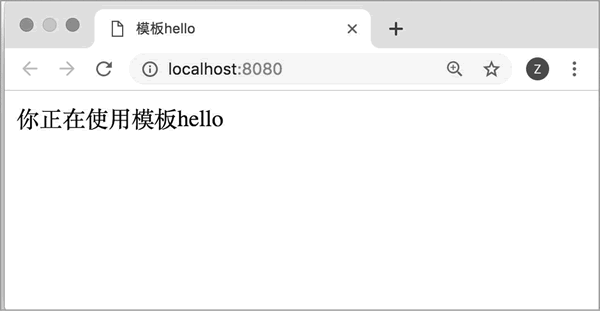 图 1 模板的效果
图 1 模板的效果这种使用模板的方法是比较简单的,只是将要输出的 html 放到单独的文件中去了。但是默认动态功能,比如说不同人看见的内容是不同。Flask 使用的是 jinja 模板,它是支持这种动态的。
模板一般包含两个动态元素,一个是变量,一个是表达式。
变量
如果需要在页面中显示欢迎人的名字,可以使用 {{变量名}} 来表示。例如,可以将前面的模板文件修改为:
<html> <head> <title>模板hello</title> </head> <body> 你({{username}})正在使用模板hello<BR> </body> </html>
然后将代码修改为:
from flask import Flask, url_for, render_template
app1 = Flask('first_flask_demo')
@app1.route('/<user_name>')
def index(user_name):
return render_template('hello2.html', username=user_name)
if __name__ == '__main__':
app1.run(debug=True, host='0.0.0.0', port=8080)
运行该代码后,在浏览器中输入 http://localhost:8080/alex,就可以看到“你(alex)正在使用模板hello”这样的输出,如图 2 所示。
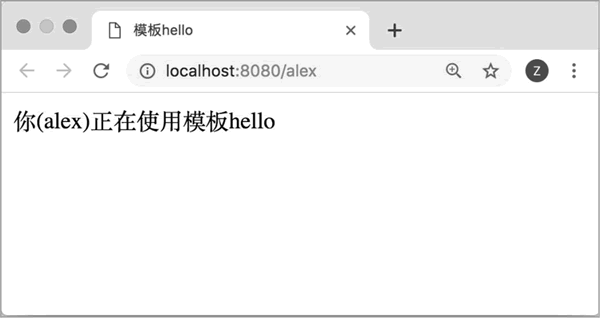 图 2 模板变量使用效果
图 2 模板变量使用效果表达式
表达式需要放在 {% 和 %} 之间。我们可在这里放任意的 Python 语句。
1) for表达式
模板内容如下:
<html> <head> <title>模板演示</title> </head> <body> <ul id=”navigation”> {% for item in href_list %} <li><a href=”{{%20item.href%20}}”>{{ item.caption }}</a></li> {% endfor %} </ul> </body> </html>
代码内容如下:
from flask import Flask, url_for, render_template
app1 = Flask('first_flask_demo')
@app1.route('/')
def index():
data = [
{"href":"back.html", "caption":"back"},
{"href":"forward.html", "caption":"forward"},
]
return render_template('hello3.html', href_list=data)
if __name__ == '__main__':
app1.run(debug=True, host='0.0.0.0', port=8080)
在浏览器中输入地址 http://localhost:8080/,可以看到如图 3 所示的内容。
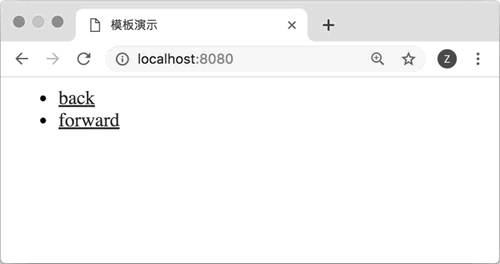 图 3 带有for语句的模板
图 3 带有for语句的模板2) if表达式
需要将 if 表达式放到 {% 和 %} 之间,还可以放入 else、endif、elif 等语句,endif 表示表达式结束。
下面是一个模板的例子,代码如下:
<!doctype html> <html> <head> <title>if语句在模板中的使用</title> </head> <body> hello, {% if gender==’male’ %} # if Mr. {% else %} # else Ms. {% endif %} # endif {{ name }}, you are {{ age }} years old now. </body> </html>
使用该模板的代码如下:
from flask import Flask, url_for, render_template
app1 = Flask('first_flask_demo')
@app1.route('/')
def index():
args = { # 给模板的参数
'name': "alex",
'gender': "male",
'age': 18
}
return render_template('ifdemo1.html', **args) # 使用模板
if __name__ == '__main__':
app1.run(debug=True, host='0.0.0.0', port=8080)
现在在浏览器中输入地址 http://localhost:8080/,便可以看到如图 4 所示的内容。
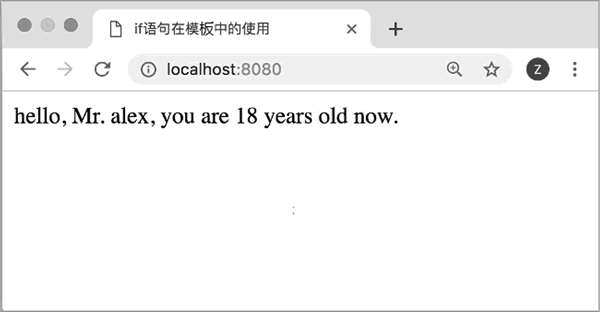 图 4 if语句在模板中的使用
图 4 if语句在模板中的使用子模板
有一个基础模板叫作 layout.html,其内容如下:
<!doctype html> <html> <head> {% block head %} <link rel=”stylesheet” href=”{{ url_for(‘static’, filename= ‘style.css’) }}”> <title>{% block title %}{% endblock %} – python_in_one</title> {% endblock %} </head> <body> <div id=”content”>{% block content %}{% endblock %}</div> <div id=”footer”> {% block footer %} © Copyright 2019 by <a href=”http://lovepython.cn/”> lovepython</a>. {% endblock %} </div> </body> </html>
下面定义一个派生的模板,命名为 subtemplate1.html,其内容如下:
{% extends “layout.html” %} {% block title %}首页{% endblock %} {% block head %} {{ super() }} <style type=”text/css”> .important { color: #336699; } </style> {% endblock %} {% block content %} <h1>首页内容</h1> <p class=”important”> 欢迎来到Python大全网站. {% endblock %}
定义代码来使用该模板,代码如下:
from flask import Flask, url_for, render_template
app1 = Flask('first_flask_demo')
@app1.route('/')
def index():
return render_template('subtemplate1.html')
if __name__ == '__main__':
app1.run(debug=True, host='0.0.0.0', port=8080)
运行该代码后,打开页面 http://localhost:8080/,可以看到如图 5 所示的内容。
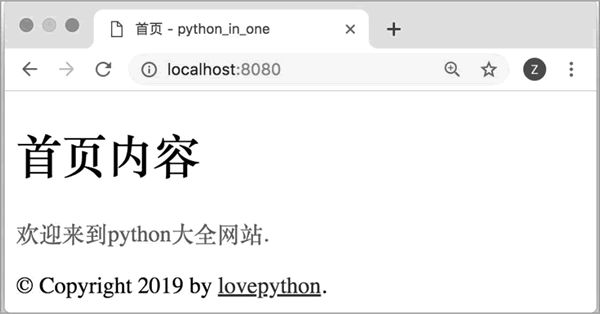 图 5 子模板的使用
图 5 子模板的使用神龙|纯净稳定代理IP免费测试>>>>>>>>天启|企业级代理IP免费测试>>>>>>>>IPIPGO|全球住宅代理IP免费测试





